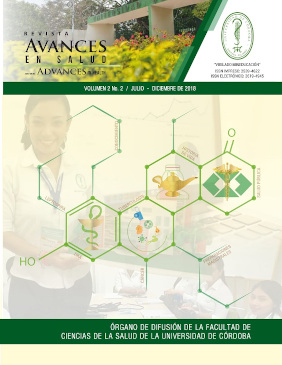Effectiveness of the Tuberculosis Control Program in state entities. Department of Cordoba, Colombia 2015
Efectividad del Programa de Control de Tuberculosis en las entidades estatales. Departamento de Córdoba -Colombia 2015.
Show authors biography
Objective. To measure the effectiveness of the Tuberculosis Control Program in the different entities of the department of Córdoba. Materials and methods. This is a descriptive and retrospective study. The researchers used data from the secondary sources relating to social, demographic, epidemiological, clinical, laboratory, treatment, final evolution, and diagnosis to analyze the behavior of the attention and the degree of therapeutic adherence to tuberculosis. Results. In 2015, the prevalence of disease was 17 cases per 1000 inhabitants. In four of the six geographic target areas, the prevalence exceeded the national average. The regions with the highest incidence were the Alto Sinú and Alto San Jorge. The lowest was the coastal and savanna areas. 79.2% of the cases were incidents, 18.8%, relapses, and 2.1%, treatment withdrawal. In 68.7% of the reviewed histories of the cases attended in the public network, no institutional evidence of activities performed to contacts was found. Patients go for the initial consultation after a period between 31 to 60 days of symptoms. 12.5% of the cases were diagnosed after 15 days of the initial consultation. In 14.6% of the cases, the tuberculosis treatment started after 16 days of the patient’s initial meeting. In 41.7%, negative sputum smear microscopy was achieved. 37.5% of those who completed their treatment but did not undergo BK at the end. 2.1% of the cases failed, and 14.6% died. The process ended with positive bacilloscopy. Conclusions. There are program management factors that delay in identifying the probable instances and initiate treatment promptly.
Article visits 1315 | PDF visits
Downloads
- Armas PL, et al. “Elementos del diagnóstico clínico y el tratamiento de la tuberculosis”. Revista Cubana de Medicina
- General Integral 12.1 (1996): 59-68.
- Tomas K. “Tuberculosis. Detección de casos, tratamiento y vigilancia. Preguntas y respuestas.” (2006).
- Lugones B, Miguel, et. al. "Apuntes históricos sobre la epidemiología, la clínica y la terapéutica de la tuberculosis en el mundo.” Revista Cubana de Higiene y Epidemiología 45.2 (2007): 0-0.
- Organización Mundial de la Salud. Centro de Prensa. Nota descriptiva N° 104. Marzo de 2.016. http://www.who.int/mediacentre/factsheets/fs104/es/
- Wyss, Kaspar, Peter Kilima, and Nicolaus Lorenz. “Costs of tuberculosis for households and health care providers in Dar es
- Salaam T.” Tropical Medicine & international health 6.1 (2001): 60-68.
- Del Corral H, et al. “IFNγ response to Mycobacterium tuberculosis, risk of infection and disease in household contacts of tuberculosis patients in Colombia.” PloS one 4.12 (2009): e8257.
- Martínez M, Miguel A. “Efecto del tratamiento acortado estrictamente supervisado (TAES) sobre la adherencia y la tasa de curación de la tuberculosis pulmonar.” Gaceta médica de México 140.1 (2004): 1-6.
- Nieto E, et al. “Cost-effectiveness of an alternative tuberculosis treatment:home-based guardian monitoring of patients.” Revista Panamericana de Salud Pública 32.3 (2012): 178-184.
- Simmon M y Fernando R. “Controversia sobre la efectividad del tratamiento supervisado en tuberculosise.” Evid. actual. práct. ambul 10.1 (2007): 23-25.
- Volmink, Jimmy y Paul Garner. “Directly observed therapy for treating tuberculosis.” Cochrane Database Syst Rev 4 (2007).
- Arrossi, Silvina, et al. “Factores predictivos de la no adherencia al tratamiento de la tuberculosis en municipios del Área Metropolitana de Buenos Aires, Argentina.” Salud colectiva 8 (2012): 65-76.
- Organización Mundial de la Salud. Estrategia mundial de la OMS para contener la resistencia a los antimicrobianos. http://www.antibioticos.msssi.gob.es/PDF/resist_OMS_estrategia_mundial_contra_resistencias.pdf
- Soza Pineda, Norma I., Susan M. Pereira, and Maurício L. Barreto. “Abandono del tratamiento de la tuberculosis en Nicaragua: resultados de un estudio comparativo.” (2005).
- Colombia. Ministerio de la Protección Social, Organización Mundial de la Salud e Instituto Nacional de Salud. Plan estrategico Colombia libre de Tuberculosis 2010 – 2.015. (2.009) [Disponible en internet] http://www.paho.org/col/index.php?option=com_content&view=article&id=431:planestrategico-colombia-libre-detuberculosis-2010-2015&Itemid=361
- Colombia, Ministerio de Salud y Protección social: https://www.minsalud.gov.co/Paginas/Tuberculosis.aspx
- Colombia. Ministerio de Salud y Protección Social. Circular externa 007 de 2.015. Anexo Técnico 2 Directrices y recomendaciones del Comité Nacional Asesor para el tratamiento de la enfermedad tuberculosa activa. Bogotá. 2105
- Organización Mundial de la Salud. Centro de Prensa. Nota descriptiva N° 104. Marzo de 2.016. http://www.who.int/mediacentre/factsheets/fs104/es/
- Ministerio de Salud y Protección Social. Circular externa 007 de 2015. Anexo Técnico 2 Directrices y recomendaciones del Comité Nacional Asesor para el tratamiento de la enfermedad tuberculosa activa. Bogotá. 2105.
- Rev Cubana Salud Pública vol.41 no.1 Ciudad de La Habana ene.-mar. 2015. Intervención educativa en trabajadores de la salud sobre la captación de sintomáticos respiratorios de tuberculosis.
- Muñoz A, Puerto A, Pedraza L. Facultad de Enfermería. Universidad Nacional de Colombia. Bogotá, D. C.
- Organización Mundial de la Salud. Centro de Prensa. Nota descriptiva N° 104. Marzo de 2.016. http://www.who.int/mediacentre/factsheets/fs104/es/







